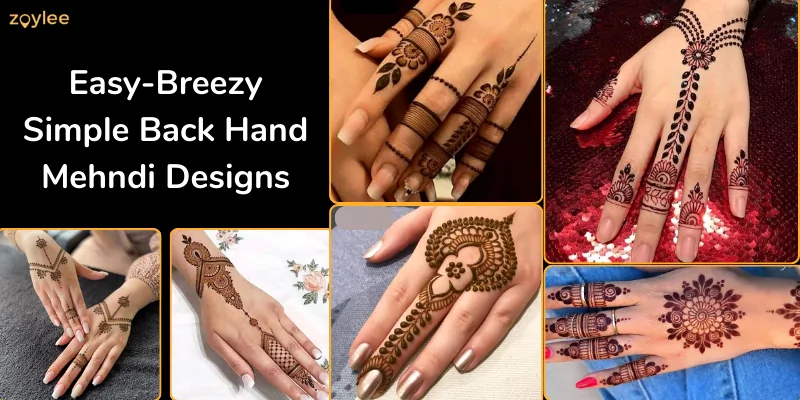Mehndi design is a traditional art form that carries significant cultural importance in various weddings and festivals such as Diwali, Karwa Chauth, and Eid. Decorating the back of your hand with intricate simple mehendi designs not only enhances your beauty but also adds an element of elegance to your overall appearance.
9 Back Hand Simple Mehndi Design for Every Festive
1. Floral Vine Mehndi Design


This design features delicate floral patterns intertwined with vines, creating a graceful and feminine look.
2. Peacock Feather Mehndi Design


Credit: Youtube
Get inspired by the majestic peacock with this design, featuring intricate feather motifs symbolizing beauty and grace.
3. Traditional Arabic Mehendi Design

Credit: m.indiamart.com
Known for its bold and geometric patterns, traditional Arabic mehendi designs are characterized by intricate details and symmetrical compositions.
4. Mandala Mehndi Design

Mandala designs are popular for their circular motifs and intricate patterns, representing unity, harmony, and balance.
5. Moroccan Mehndi

Moroccan mehndi designs are known for their geometric shapes and repetitive patterns, creating a mesmerizing visual effect.
6. Paisley Mehndi Design

Paisley motifs, also known as “mango designs,” are a classic element of mehndi art, symbolizing fertility, prosperity, and abundance.
7. Minimalist Mehndi Design

Credit: Pinterest
For those who prefer a subtle and understated look, minimalist design feature simple yet elegant patterns that enhance the natural beauty of the hand.
8. Indo-Arabic Fusion Mehndi Design

Combining elements of Indian and Arabic mehendi styles, Indo-Arabic fusion designs feature a harmonious blend of intricate patterns, floral motifs, and geometric shapes.
Read Also: Simple and Easy Mehndi Design for Front and Back Hand 2024
9. Glitter Mehndi Designs


Credit: Pinterest
Add a touch of sparkle to your mehendi design with glitter accents, which enhance the overall look and make the design stand out.
Conclusion
These stunning mehendi designs for the back hand are sure to add a touch of elegance and charm to any occasion. Whether you prefer traditional Indian designs, Arabic patterns, or minimalist styles, there’s something for everyone in this collection. So go ahead, choose your favorite design, and elevate your look with the timeless art of mehendi!
FAQs
How do you apply simple mehndi designs?
To apply simple Mehndi designs, start by choosing a design you like. Prepare natural henna paste by mixing henna powder with water and a few drops of lemon juice or tea tree oil for better color. Use a cone or a Mehndi applicator to trace the design onto clean, dry skin. Let it dry naturally for a few hours, then gently scrape off the dried henna paste. Avoid washing the area with water for at least 12 hours to allow the color to develop fully.
How to get dark stains of mehndi?
To achieve dark Mehndi stains, start by ensuring the henna paste is fresh and of good quality. After applying the paste, leave it on the skin for at least 4-6 hours or preferably overnight. Keep the area warm as warmth helps the dye release. Once dry, gently scrape off the dried paste and avoid washing the area with water for the first 24 hours to allow the stain to deepen.
How to learn henna at home?
To learn henna at home, start by gathering quality henna powder, essential oils like eucalyptus or tea tree, and mixing them to form a paste. Practice applying designs on paper or on your skin using cones or squeeze bottles for precision. Watch tutorials online to improve technique and experiment with different patterns and styles.
How to hold a mehendi cone?
Hold the Mehendi cone like you would hold a pen or pencil, ensuring a firm grip with your thumb and index finger. Apply gentle pressure to control the flow of henna while creating intricate designs on your skin. Adjust your grip as needed to maintain precision throughout the application process.
How to make mehndi at home with leaves?
To make Mehndi at home with leaves, first dry and crush fresh henna leaves into a fine powder. Mix the powder with lemon juice or brewed tea to form a paste. Let it sit for a few hours to release dye, then apply the paste onto the skin in desired designs and let it dry before scraping off.


